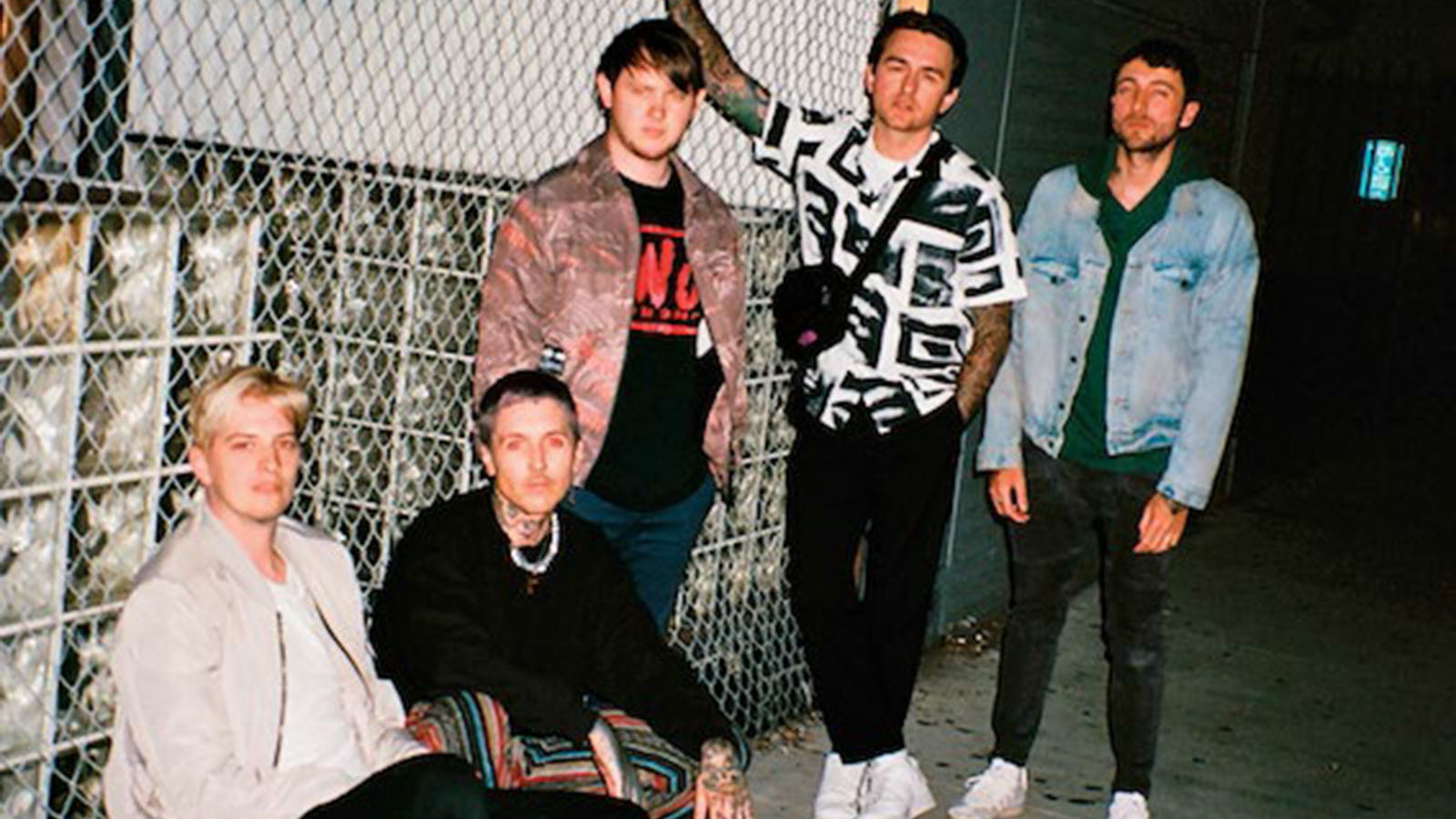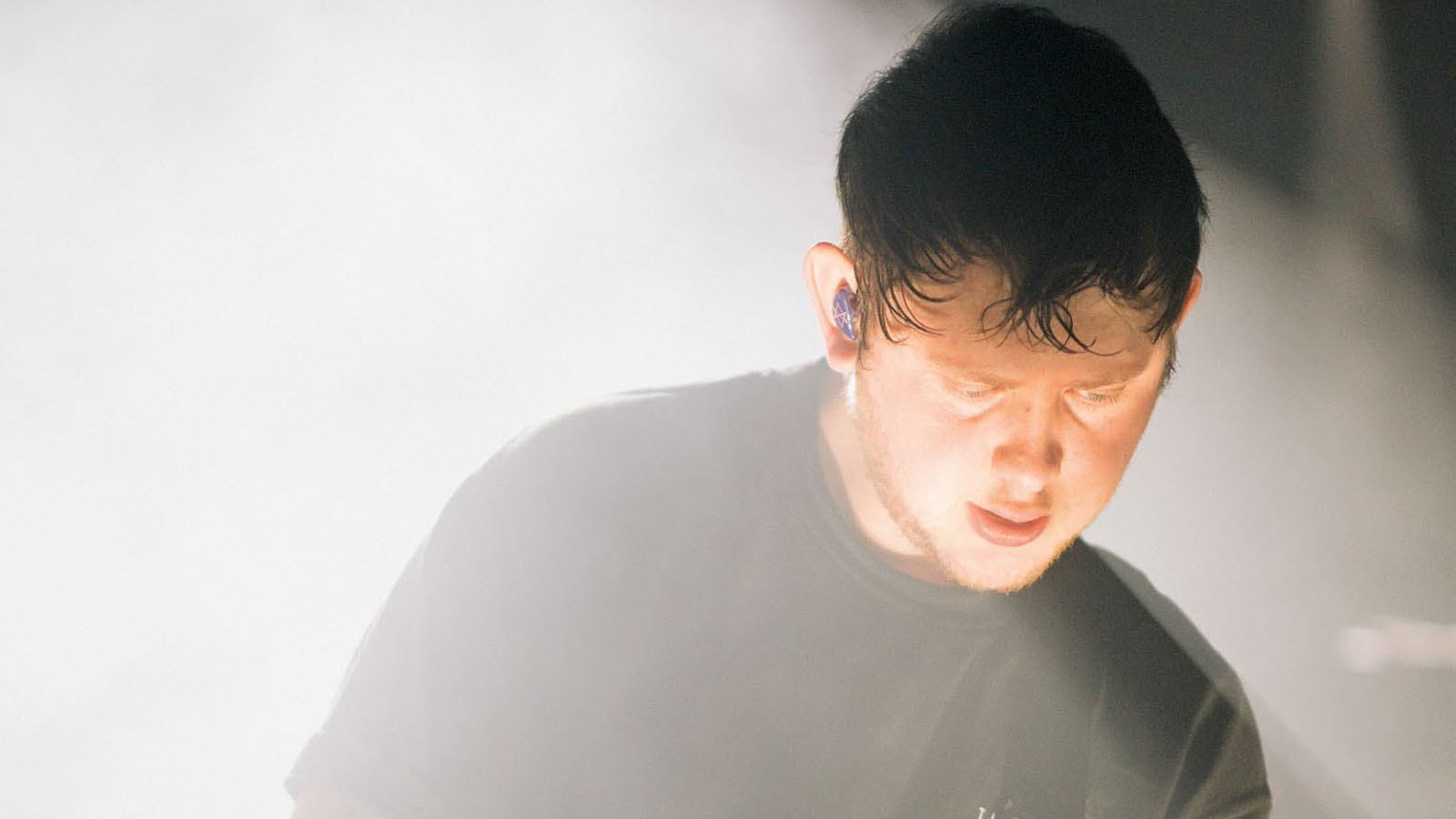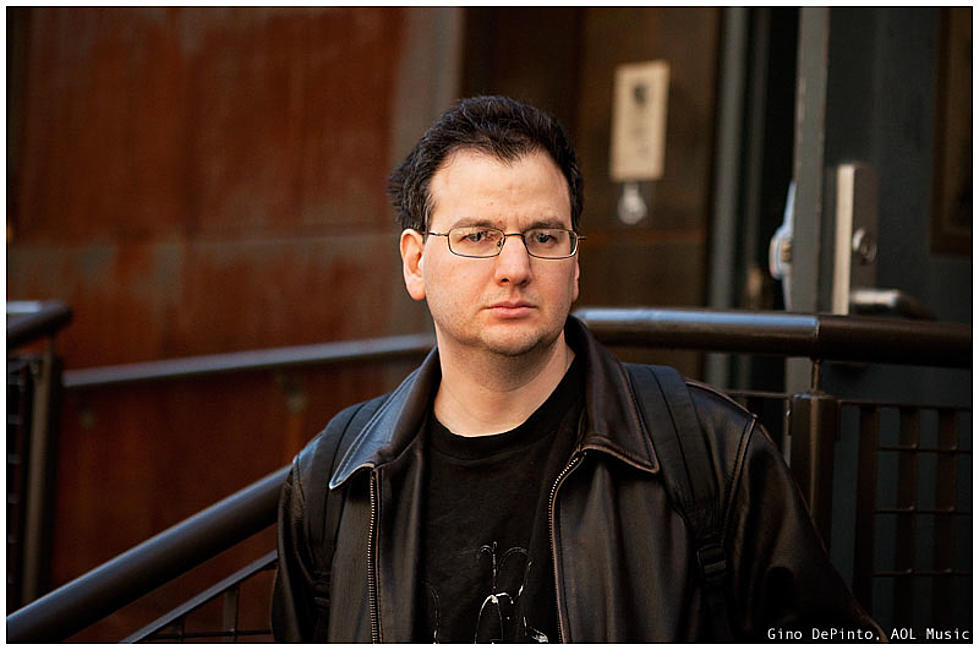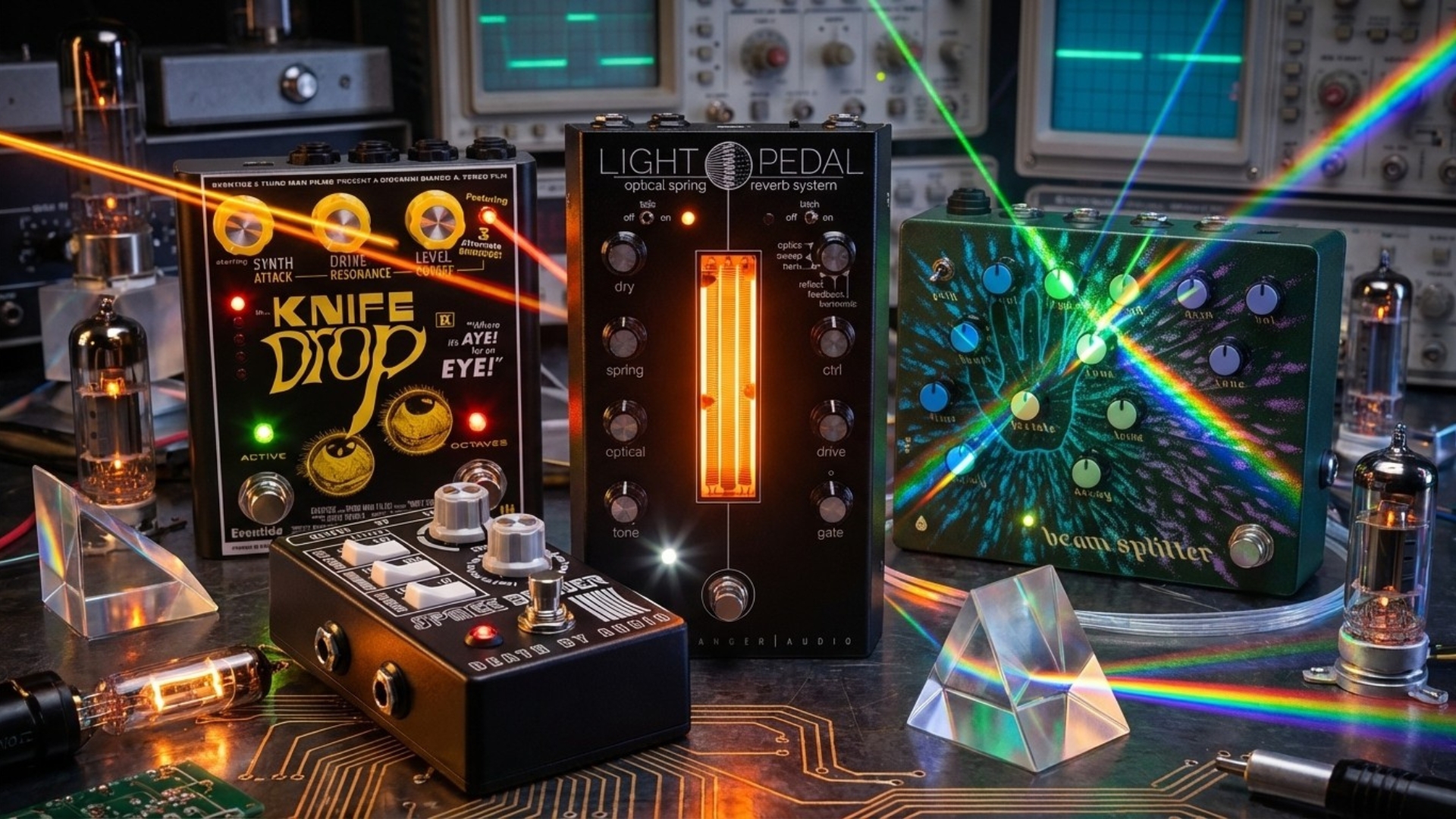Bring Me the Horizon's Lee Malia Lifts the Veil on 'Amo,' Their Genre-Jumping New Album
“What would be the point of giving people exactly what they expect every album?”

As they tour North America to support their sixth album, Amo, Sheffield, England, rockers Bring Me the Horizon are suffering from a bit of an identity crisis. On one level, the band that emerged from the Nineties deathcore scene with a mix of roaring vocals, atonal riffs and seismic breakdowns still wants to maintain some of their metal cred, which they recently demonstrated before a packed crowd at New York’s Hammerstein Ballroom. After opening with the swirling synth-pop number “I Apologize If You Feel Something,” the group kicked into “Mantra,” the first single from amo. The song, one of the heavier tracks on the album, sounded even more trenchant live as guitarist Lee Malia coaxed volleys of fuzzed-out riffs through his custom Epiphone and a Marshall 800.
The band followed the song with the anthemic “House of Wolves” from 2013’s Sempiternal, Bring Me the Horizon’s delicate foray out of metal and into arena rock. Since then, they’ve ramped up the melodies even further and turned down the gain. To their credit, they’ve also become more adventurous as songwriters, experimenting with a wide range of styles, including altrock, hard rock, electronic pop, hip-hop and EDM. There were lightweight moments during the New York performance, including the melancholy atmospherics of “Medicine,” that were greeted with indifference by fans of the heavy stuff. This indicates, perhaps, how carefully Bring Me the Horizon are walking a tightrope to retain fans from their musically chaotic past while attracting a new crowd with their more adventurous new material.
“Some people who liked us in the beginning are trying to figure out what we are now,” admits Malia, sitting on the bed at his home in Sheffield and talking on the phone while his wife entertains guests downstairs. “These days, I think we’re like two different bands. What we are on album is quite different than what we sound like live. Onstage, we still want to be really intense and exciting and we make a lot of the newer songs more energetic by playing them with more aggression and changing some of the parts around. I think it keeps what we do interesting for us and for the audience.”
For the most part, it’s not the live shows that are dividing the band’s fan base. Like Linkin Park and Muse, Bring Me the Horizon have sacrificed aggression and grit for a more diverse and radio-friendly style of songwriting. amo is packed with well-crafted, hook-filled tunes, but only a few feature riffs that could roughly be categorized as hard rock, let alone metal. Elsewhere, there are alt-pop melodies, ambient electronic washes, blipping keyboards, skittering drum machines, clean, chiming guitars and heavily processed vocals. The results have left many fans scratching their heads.
“What would be the point of giving people exactly what they expect every album?” Malia says. “We’ve tried to evolve with every album and I really think that’s what has kept us relevant. Instead of following trends we’ve separated ourselves from other bands from the scene we were in. We’ve been away from the pack for our entire career and that enabled us to develop however we wanted to.”
Having just been nominated for their first Grammy for “Mantra,” which is up for Best Rock Song (Editor’s note: They lost to St. Vincent), Bring Me the Horizon seem to be on a path to success, regardless of how fans of their first three or four albums might feel about it. Perhaps more importantly, the band members (Malia, vocalist Oli Sykes, bassist Matt Kean, keyboardist Jordan Fish and drummer Matt Nicholls) are no longer worried about making music to appeal to a particular demographic, which explains why amo features such disparate guest vocalists as Cradle of Filth’s Dani “Filth” Davey (“Wonderful Life”), female indie-pop singer Grimes (“Nihilist Blues”) and Rapper Rahzel (“Heavy Metal”). No one’s more aware of the risks they’ve taken than the band members themselves, as evident from the lyrics of “Heavy Metal”: “I’m afraid you don’t love me anymore / ’Cause a kid on the ’gram in a Black Dahlia tank says it ain’t heavy metal / And that’s alright, that’s alright.”
Did you consciously take a different approach to guitar with amo than you did on 2015’s That’s the Spirit?
All the latest guitar news, interviews, lessons, reviews, deals and more, direct to your inbox!
I wanted to have a lot of weird and different sounds on this CD and a bunch of different guitar tones. Usually when we do a record I go into the studio and get a heavy sound and then every heavy sound on every song is pretty much the same. And every clean sound is basically the same as well. On this CD, we started every single song from scratch. Then we built the guitar tones around the songs rather than having a general sound for the heavy parts and light parts.
How did you determine which tones were right for what songs?
We tried a lot of different amps and I played a lot of different guitars. I used a lot of fuzz pedals to get different kinds of distorted sounds that sat well with the synths. I liked when we could get the two to merge into this wall of sound rather than being two different sounds going at the same time.
What was your greatest challenge this time around?
Being confident and comfortable enough to not play on certain sections. It’s quite scary for a guitarist to back off and not do anything during a verse. But as the band has grown we’ve realized that if a part doesn’t need a guitar, what’s the point in playing just to fuel your ego? So, I’d always try something and if it didn’t add anything to the song, I’d go, “Actually, I don’t think I should play on this part.”
Four years has passed between the release of That’s the Spirit and amo. Were there any major life events during that time that colored the new record?
I got married, which was really big for me. And our singer Oli went through quite a lot. He got married, went through a divorce, met someone else and got married again. So a lot of the album is about the changes he went through. Once you have a lyrical direction it gives you a map that you can use to shape the whole album, and that’s when the songs develop the feeling you’re after and start making sense musically.
You started writing songs for amo in December 2017. At that point, did you know the album was going to address the collapse of a marriage and the rebirth that followed?
Not at all. At first, Oli said he wasn’t sad about what was going on anymore so he didn’t want to sing about it. Then, halfway through he finally decided he had to write about it because it was what he had actually experienced and it was the only way the songs would be authentic.
amo is your most musically eclectic offering. You explore a variety of music styles, from delicate and vulnerable electronic pop to quirky hard rock. Were you ever worried that the album would be too schizophrenic?
Halfway through writing the CD, we looked at each other and went, “What is going on? This is crazy. It’s all over the place and it’s weird.” We didn’t even know if it was any good. But when we listened back again we reassessed everything and we decided we liked it and that’s all that mattered. For us, it’s a way more interesting album than That’s the Spirit because with That’s the Spirit we wanted to make 10 songs of arena rock with singalong choruses. This time, we wanted to do something less predictable and more out there. When we accepted that that album is what it is and we weren’t going to worry what people thought about it or how it might change our fan base, we had fun experimenting with stuff and being creative.
Was there a moment in the process when everything clicked for you?
We realized we were onto something when we recorded the first single, “Mantra.” We spent a lot of time writing it and making something that was catchy enough to be able to go on the radio but still heavy enough to keep our old fans from getting pissed off. We released it before we finished the record and the reaction was quite good. That was quite a relief and motivated us to do stuff that was even more diverse and finish the record on our terms.

What are some of the creative touches you’re most pleased with?
I used an EBow on some of the sections, which brings an added layer of emotion to the music. And I used lots of different Earth-Quaker Devices pedals, including the Fuzzmaster General, to get some gnarly tones. I also liked using the Electro-Harmonix Micro POG Polyphonic Octave Generator pedal. I often used it to play a section an octave down to make it sound thicker. A lot of the experimentation on the CD is subtle and involves layers of sound that aren’t the main focus, but if you listen closely you can hear all these other things going on. I love doing that because it gives the music more texture.
You wrote the score for the 2017 horror movie Pyewacket. Did working on that give you ideas for textural approaches you could use in Bring Me the Horizon?
I didn’t really use guitar on that soundtrack. I made a lot of the weird sounds for the score by hitting the strings in the back of an old piano. It was good to be able to explore those kinds of soundscapes and maybe it influenced me in the way I layered things on amo and experimented a lot with mood.
Are you a big fan of soundtracks and film scores?
I’ve been listening to ambient music and acoustic stuff for a long time and I’ve learned to incorporate that in our songs. I love Trent Reznor’s movie stuff and Mark Korven, who did music for The Witch. Hearing that kind of stuff has inspired me to look at a guitar in a different way that I used to.
The band took a year off after touring for That’s the Spirit. Did that allow you to recharge the batteries and approach songwriting from a new perspective?
I think it helped. When we released Sempiternal in 2013 we got a lot bigger and a lot more people started listening to us. Since we wanted to capitalize on all the new attention, we rushed right into That’s the Spirit. We were touring and recording and writing constantly for a long time, and we got kind of burned out. So it was great to have the time away and then come back and look at what we were doing with fresh eyes.
Do you enjoy your privacy when you’re off the road or do you still spend time together?
We’re best friends. We hang out all the time. Even when we don’t see each other, we talk every day. And every Monday, me and [drummer] Matt Nicholls play five-aside football.
Bring Me the Horizon started out in 2004 as a corrosive screamo/deathcore band. In just 15 years, you’ve transformed into a much more adept and diverse outfit. Newcomers might be shocked to hear 2006’s Count Your Blessings and 2008’s Suicide Season (which featured cover art of a woman in a black dress holding ropes of blood-dripping entrails).
When we first began the band I was 17 or 18 and the whole purpose of making music was to write the heaviest-sounding songs we possibly could and then do a super-heavy breakdown. I grew up loving Metallica and At the Gates and wanting to play really metallic guitar. Now we’re far more interested in working to make a song super catchy and good so it sticks in your head rather than just make something that’s heavy.
When did you come to that realization?
It came over time as we got into different kinds of music. When we wrote There Is a Hell, Believe Me I’ve Seen It. There Is a Hell, Let’s Keep it a Secret [in 2010], we experimented a bit with choirs and strings, but Oli wasn’t doing any clean singing back then, so we could only go so far with the soft sections of the songs. Then, when Oli started to sing with melody in Sempiternal, it opened a lot of creative doors and we’ve continued to grow from there. amo has so many different styles but it still sounds like us. When I think of classic bands, like Queen or the Beatles, a lot of their albums have got so many genres in them. Not to say we sound anything like them, but I think an album becomes interesting when it goes in a lot of different directions rather than following one continuous kind of sound.
Do you write in the studio or record demos in advance?
We demo everything. I have a Kemper that’s looped into a computer, which is a quick way to work with ideas. I can record a guitar riff then program some drums to it, and within a minute you get what the general sound is gonna be. Me, [programmer and co-producer] Jordan and Oli will listen back to that and if it sounds good we’ll carry on and if it doesn’t then we’ll start again. That’s a much faster way to work than to come up with a riff and then teach it to the bassist and wait for the drummer to come up with a part for it, which is what we used to do. That type of songwriting was so much more time-consuming and stressful because it was loud and chaotic and it was impossible to think. Now we’ve kind of got it down to a science.
When did you enter the studio to record, and did you have complete tracks to work with?
We had 30 ideas for different songs when we started working on them in the end of January 2018. But they were all, like, one-minute sections. There were riffs, not songs. And the songs still weren’t 100 percent there when we started recording. If something wasn’t exactly the way we wanted it, we did a lot of tweaking until we were happy with it. We recorded everything America in May and June. The vocals were done at the studio owned by the Madden brothers [from Good Charlotte] and we also used the studio across the road. I’d go over to the Madden brothers’ place and we’d all sit and finish the guitar parts and then go over it so we could record the whole song. Everything was finally done by September 2018.
What was the hardest song to record?
We rewrote “Sugar Honey Ice & Tea” a bunch of times because no matter what we did, it didn’t seem to work. Originally, the verse sounded r&b to us and that didn’t sit right. So we went back and made the riff heavier, but then it was too intense. It took us so long to get it right. We kept going back and changing it and changing it.
You used your signature Epiphone with a Kemper for the demos. Did you use the same setup when you tracked the album?
I used my signature Epiphone a lot because I know exactly how to get certain sounds out of that guitar. But I worked with different amps. We used a Marshall 800 a lot, but when we needed a bit more gain we used a Wizard Modern Classic, which was an amp I hadn’t heard before, but which had a great bite. Then, for the clean sections, we usually used a Marshall JCM45 and a Vox AC30. But we kept switching up amps, guitars and pedals and used whatever sounded best. Our engineer got me to try a 1965 Gibson 335 that the studio had. I used that for a couple sections and it was one of the nicest-sounding guitars I’ve ever played. And then, I’ve got a First Act guitar that’s dying, but we got it to work and it sounds kinda like a bass but with this really cool tone. And when I wanted a sound that wasn’t clean but wasn’t as dense as I got with the Epiphones or Gibson, I used a Fender Strat.
You experimented with guitars, effects and amps. Did you use a variety of tunings as well?
It’s virtually all over the place. For the lowest tuning, my low E string is tuned to G. Then, there’s a bunch of songs in standard tuning. There are songs in D standard, Drop C and C Standard. I have eight guitars with me on the road and they’re all tuned differently.
How do you translate your studio sound in a live environment?
I use an 800 as my main gain sound and I run a Klon Klone pedal into that for a bit more gain and bite. For clean I use a JCM45 Marshall. We just changed my rig so it’s all controlled by MIDI controller and all my pedals are racked. I also put a Kemper in the rack and I use it to make strange noises and when I want my guitar to sound like a bass. I’m using it as an effects unit rather than an amp.
Having started out as an extreme metal band with no real aspirations of appealing to the mainstream, is it surreal to be playing arenas and getting nominated for awards?
It’s definitely mind-boggling to realize that in 2004 we released this quite wild, noisy four-song EP [This Is What the Edge of Your Seat Was Made For] that we couldn’t even afford to do. Someone else paid for it to get recorded. And now we’ve got gold discs and a Grammy nomination. Every time something crazy happens, it takes a long time to get used to it. But we don’t take it for granted and we’re quite lucky that success didn’t happen right away. If it did, we would have had nowhere to aim and nothing to build up to. If you get huge instantly, you can only go downhill.
Jon is an author, journalist, and podcaster who recently wrote and hosted the first 12-episode season of the acclaimed Backstaged: The Devil in Metal, an exclusive from Diversion Podcasts/iHeart. He is also the primary author of the popular Louder Than Hell: The Definitive Oral History of Metal and the sole author of Raising Hell: Backstage Tales From the Lives of Metal Legends. In addition, he co-wrote I'm the Man: The Story of That Guy From Anthrax (with Scott Ian), Ministry: The Lost Gospels According to Al Jourgensen (with Al Jourgensen), and My Riot: Agnostic Front, Grit, Guts & Glory (with Roger Miret). Wiederhorn has worked on staff as an associate editor for Rolling Stone, Executive Editor of Guitar Magazine, and senior writer for MTV News. His work has also appeared in Spin, Entertainment Weekly, Yahoo.com, Revolver, Inked, Loudwire.com and other publications and websites.

